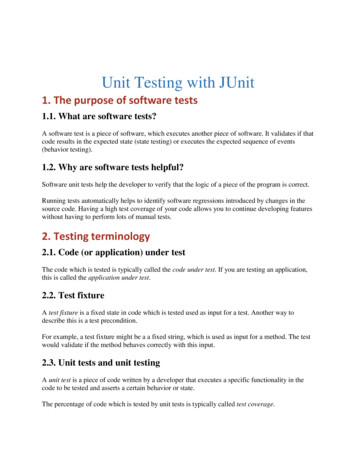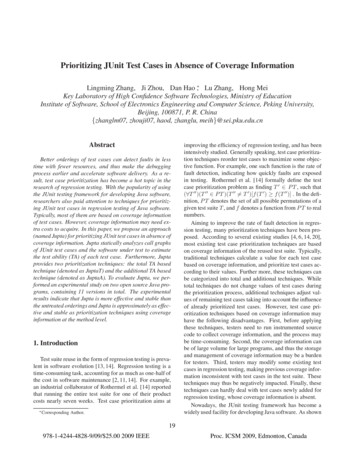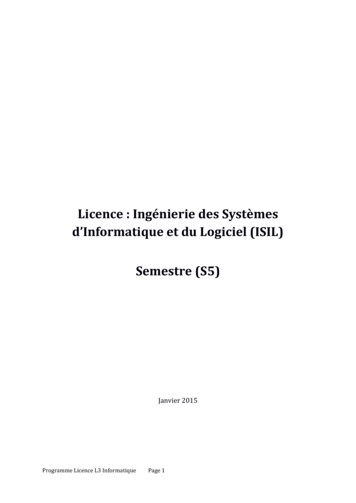
Transcription
Unit Testing with JUnit1. The purpose of software tests1.1. What are software tests?A software test is a piece of software, which executes another piece of software. It validates if thatcode results in the expected state (state testing) or executes the expected sequence of events(behavior testing).1.2. Why are software tests helpful?Software unit tests help the developer to verify that the logic of a piece of the program is correct.Running tests automatically helps to identify software regressions introduced by changes in thesource code. Having a high test coverage of your code allows you to continue developing featureswithout having to perform lots of manual tests.2. Testing terminology2.1. Code (or application) under testThe code which is tested is typically called the code under test. If you are testing an application,this is called the application under test.2.2. Test fixtureA test fixture is a fixed state in code which is tested used as input for a test. Another way todescribe this is a test precondition.For example, a test fixture might be a a fixed string, which is used as input for a method. The testwould validate if the method behaves correctly with this input.2.3. Unit tests and unit testingA unit test is a piece of code written by a developer that executes a specific functionality in thecode to be tested and asserts a certain behavior or state.The percentage of code which is tested by unit tests is typically called test coverage.
A unit test targets a small unit of code, e.g., a method or a class. External dependencies should beremoved from unit tests, e.g., by replacing the dependency with a test implementation or a (mock)object created by a test framework.Unit tests are not suitable for testing complex user interface or component interaction. For this,you should develop integration tests.2.4. Integration testsAn integration test aims to test the behavior of a component or the integration between a set ofcomponents. The term functional test is sometimes used as synonym for integration test.Integration tests check that the whole system works as intended, therefore they are reducing theneed for intensive manual tests.These kinds of tests allow you to translate your user stories into a test suite. The test wouldresemble an expected user interaction with the application.2.5. Performance testsPerformance tests are used to benchmark software components repeatedly. Their purpose is toensure that the code under test runs fast enough even if it’s under high load.2.6. Behavior vs. state testingA test is a behavior test (also called interaction test) if it checks if certain methods were calledwith the correct input parameters. A behavior test does not validate the result of a method call.State testing is about validating the result. Behavior testing is about testing the behavior of theapplication under test.If you are testing algorithms or system functionality, in most cases you may want to test state andnot interactions. A typical test setup uses mocks or stubs of related classes to abstract theinteractions with these other classes away Afterwards you test the state or the behavior dependingon your need.2.7. Testing frameworks for JavaThere are several testing frameworks available for Java. The most popular ones are JUnit andTestNGThis description focuses on JUnit. It covers both JUnit 4.x and JUnit 5.
2.8. Where should the test be located?Typical, unit tests are created in a separate project or separate source folder to keep the test codeseparate from the real code. The standard convention from the Maven and Gradle build tools is touse: src/main/java - for Java classes src/test/java - for test classes3. Using JUnit3.1. The JUnit frameworkJUnit is a test framework which uses annotations to identify methods that specify a test. JUnit isan open source project hosted at Github.3.2. How to define a test in JUnit?A JUnit test is a method contained in a class which is only used for testing. This is called a Testclass. To define that a certain method is a test method, annotate it with the @Test annotation.This method executes the code under test. You use an assert method, provided by JUnit oranother assert framework, to check an expected result versus the actual result. These method callsare typically called asserts or assert statements.You should provide meaningful messages in assert statements. That makes it easier for the user toidentify and fix the problem. This is especially true if someone looks at the problem, who did notwrite the code under test or the test code.3.3. Example JUnit testThe following code shows a JUnit test using the JUnit 5 version. This test assumes thatthe MyClass class exists and has a multiply(int, int) method.import static rt org.junit.jupiter.api.Test;public class MyTests {@Testpublic void multiplicationOfZeroIntegersShouldReturnZero() {
MyClass tester new MyClass(); // MyClass is tested// assert statementsassertEquals(0, tester.multiply(10, 0), "10 x 0 must be0");assertEquals(0, tester.multiply(0, 10), "0 x 10 must be0");assertEquals(0, tester.multiply(0, 0), "0 x 0 must be0");}}3.4. JUnit naming conventionsThere are several potential naming conventions for JUnit tests. A widely-used solution for classesis to use the "Test" suffix at the end of test classes names.As a general rule, a test name should explain what the test does. If that is done correctly, readingthe actual implementation can be avoided.One possible convention is to use the "should" in the test method name. For example,"ordersShouldBeCreated" or "menuShouldGetActive". This gives a hint what should happen ifthe test method is executed.Another approach is to use tedResult]"for the display name of the test method.4. Using JUnit 44.1. Defining test methodsJUnit uses annotations to mark methods as test methods and to configure them. The followingtable gives an overview of the most important annotations in JUnit for the 4.x and 5.x versions.All these annotations can be used on methods.Table 1. AnnotationsJUnit 4Descriptionimport org.junit.*Import statement for using the following annotations.
Table 1. AnnotationsJUnit 4Description@TestIdentifies a method as a test method.@BeforeExecuted before each test. It is used to prepare the test environment (e.gclass).@AfterExecuted after each test. It is used to cleanup the test environment (e.g.defaults). It can also save memory by cleaning up expensive memory st@BeforeClassExecuted once, before the start of all tests. It is used to perform time inconnect to a database. Methods marked with this annotation need to beJUnit.@AfterClassExecuted once, after all tests have been finished. It is used to perform cdisconnect from a database. Methods annotated with this annotation newith JUnit.@Ignore or @Ignore("Whydisabled")Marks that the test should be disabled. This is useful when the underlyitest case has not yet been adapted. Or if the execution time of this test ipractice to provide the optional description, why the test is disabled.@Test (expected Exception.class)Fails if the method does not throw the named exception.@Test(timeout 100)Fails if the method takes longer than 100 milliseconds.4.2. Assert statementsJUnit provides static methods to test for certain conditions via the Assert class. These assertstatements typically start with assert. They allow you to specify the error message, theexpected and the actual result. An assertion method compares the actual value returned by a testto the expected value. It throws an AssertionException if the comparison fails.The following table gives an overview of these methods. Parameters in [] brackets are optionaland of type String.
Table 2. Methods to assert test resultsStatementDescriptionfail([message])Let the method fail. Might be used to check that a certain part of thefailing test before the test code is implemented. The message parameassertTrue([message,] booleancondition)Checks that the boolean condition is true.assertFalse([message,] booleancondition)Checks that the boolean condition is false.assertEquals([message,] expected,actual)Tests that two values are the same. Note: for arrays the reference isassertEquals([message,] expected,actual, tolerance)Test that float or double values match. The tolerance is the number oassertNull([message,] object)Checks that the object is null.assertNotNull([message,] object)Checks that the object is not null.assertSame([message,] expected,actual)Checks that both variables refer to the same object.assertNotSame([message,] expected,actual)Checks that both variables refer to different objects.4.3. JUnit test suitesIf you have several test classes, you can combine them into a test suite. Running a test suiteexecutes all test classes in that suite in the specified order. A test suite can also contain other testsuites.The following example code demonstrates the usage of a test suite. It contains two test classes(MyClassTest and MySecondClassTest). If you want to add another test class, you can add it tothe @Suite.SuiteClasses statement.package com.vogella.junit.first;import org.junit.runner.RunWith;import org.junit.runners.Suite;
import lassTest.class })public class AllTests {}
Unit Testing with JUnit 1. The purpose of software tests 1.1. What are software tests? A software test is a piece of software, which executes another piece of software. It validates if that code results in the expected state (state testing) or executes the expected sequence of events (behavior testing). 1.2. Why are software tests helpful?










